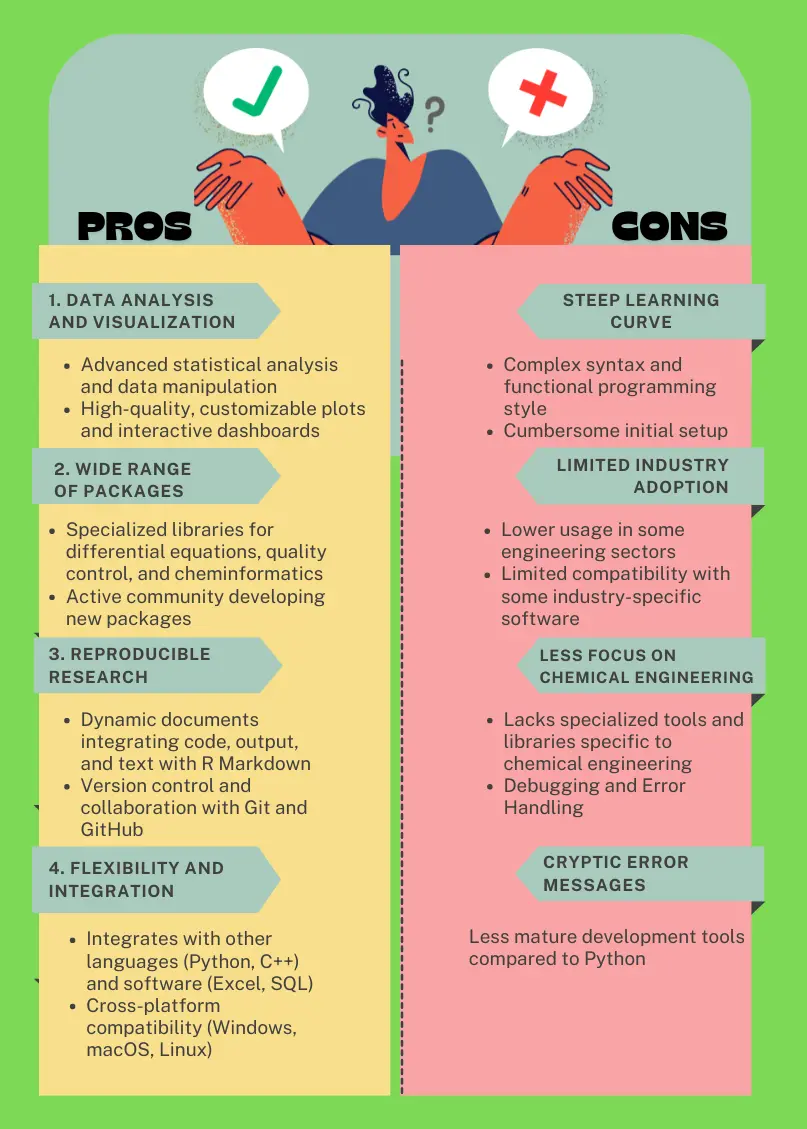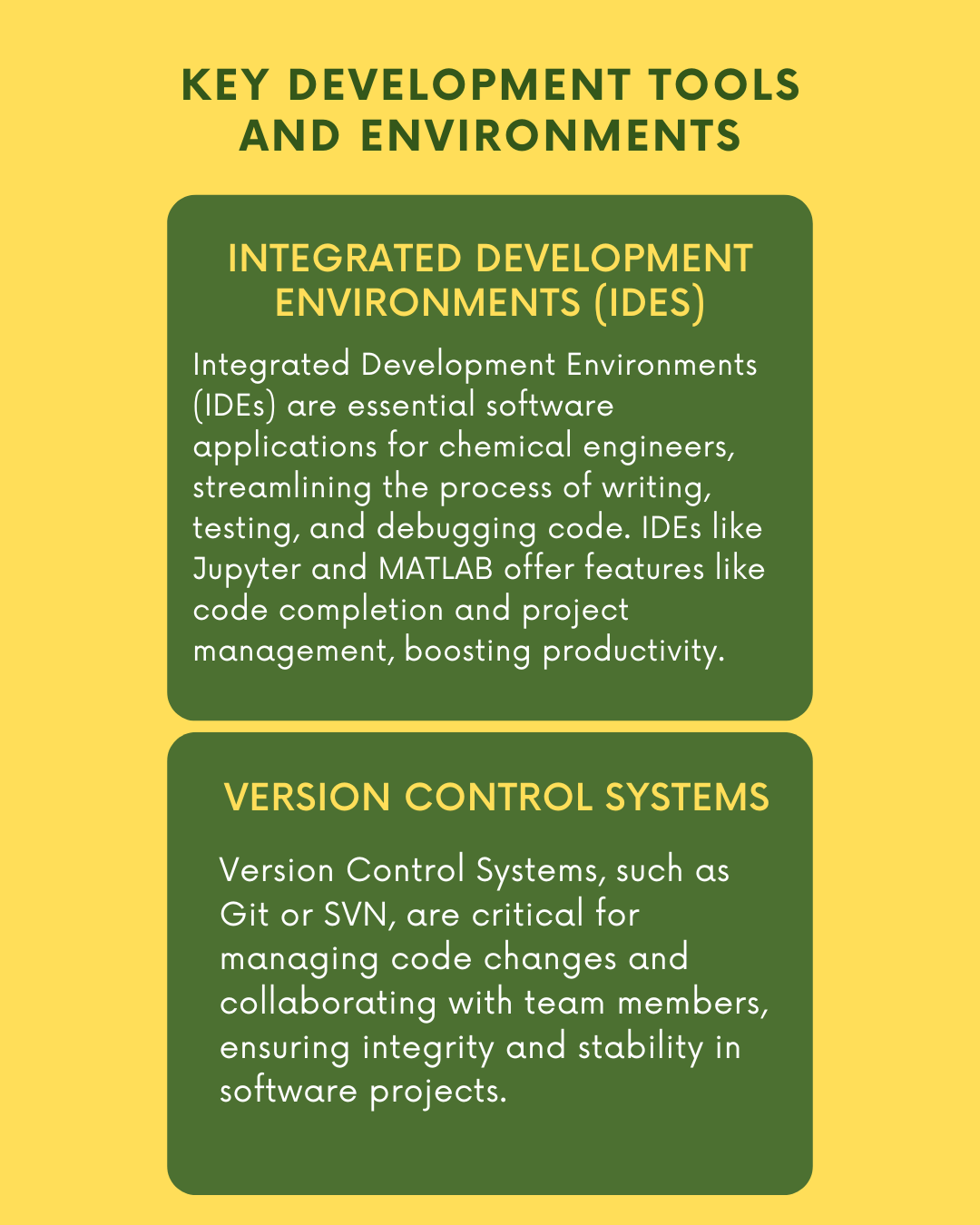Hey, all you chemical engineers out there!
Ever wondered which computer language could make your job easier?
Well, you’re in luck!
Knowing the right technology or tool can help you solve chemical problems faster and better. So, put on your lab coats and safety glasses, because we’re about to explore the best programming languages that are most beneficial and necessary in today’s competitive industry for chemical engineers looking to optimize processes, analyze data, and simulate complex systems.
Just like chemicals react differently under specific conditions, coding languages have unique properties that cater to different needs. As technology continues to advance, it has become increasingly important to have a solid understanding of programming to thrive in their careers.
Let’s mix some code with chemistry and see which language is the best fit for your work!
Popular Choices:
- Python: Favored by chemical engineers for its simplicity, readability, and extensive libraries for data analysis and visualization.
- Matlab: Widely used for its powerful numerical computing capabilities and robust toolboxes for simulations and modeling.
- FORTRAN: Still relevant for its efficiency in handling complex mathematical computations and large-scale simulations.
- C++: Preferred for developing high-performance and computationally intensive applications due to its speed and memory management features.
- Julia: Popular for its high-level syntax, fast execution speed, and compatibility with existing code written in Python, C, and Fortran.
In-Depth Analysis of Top Languages for Chemical Engineers
-
Python for Chemical Engineering
Its popularity stems from its ability to streamline complex tasks while maintaining a user-friendly interface. Chemical engineering, being a discipline rich in data analysis, simulation, and optimization, finds Python to be an invaluable tool due to its extensive capabilities.
Applications
Data analysis and visualization: Libraries such as NumPy and Pandas enable engineers to analyze vast datasets efficiently. With tools like Matplotlib and Seaborn, visualizing complex data becomes intuitive, facilitating deeper insights into process dynamics and performance.
Process simulation and optimization: Frameworks like SciPy and SymPy empower the development of sophisticated models for process simulation and optimization. From reactor design to heat exchanger analysis, Python’s numerical computing capabilities enhance the efficiency and accuracy of engineering calculations.
Machine learning and AI for predictive modeling: With the advent of machine learning and artificial intelligence, cutting-edge libraries like TensorFlow and Scikit-learn. Chemical engineers leverage these tools to develop predictive models for process control, fault detection, and quality prediction, thereby optimizing plant operations and resource utilization.
Advantages
Extensive libraries for scientific computing: Rich ecosystem of specialized libraries tailored for scientific computing, including NumPy for numerical computations, SciPy for scientific algorithms, and Pandas for data manipulation. These libraries provide powerful tools for tackling complex engineering problems efficiently.
Easy-to-learn syntax and readability: The syntax emphasizes readability and simplicity, making it accessible to both novice and experienced programmers alike. Engineers can quickly grasp concepts and syntax, allowing them to focus on problem-solving rather than wrestling with the intricacies of the language itself.
Large community support and active development: Vast and vibrant community of developers, researchers, and enthusiasts who contribute to its continuous development and evolution. This community-driven approach ensures timely updates, bug fixes, and the availability of a plethora of resources, including tutorials, forums, and open-source projects, which benefit chemists seeking to expand their programming skills.
Disadvantages of Python
Slower execution speed compared to compiled languages: Despite its versatility, It is an interpreted language, which can result in slower execution speed compared to compiled languages like C/C++. For computationally intensive tasks requiring high-performance computing, Python may not always be the optimal choice.
GIL (Global Interpreter Lock) limitations for multi-threaded applications: Global Interpreter Lock (GIL) can pose limitations for multi-threaded applications, as it restricts concurrent execution of Python threads within a single process. This can impact the scalability of certain parallel computing tasks in chemical applications.
Case studies
Optimization of chemical processes: Python-based optimization algorithms are utilized to enhance the efficiency and profitability of chemical processes by minimizing energy consumption, maximizing yield, and optimizing operating conditions.
Predictive maintenance in industrial plants: The machine learning models are deployed to predict equipment failures and perform preventive maintenance in chemical plants, thereby reducing downtime and maintenance costs while improving safety and reliability.
Environmental impact assessment: Employed to analyze and model the environmental impact of chemical processes, aiding in regulatory compliance and sustainable development initiatives.
-
MATLAB for Chemical Engineering
MATLAB, short for “Matrix Laboratory,” is a high-level language and interactive environment widely used in engineering and scientific computing. Its intuitive syntax, powerful built-in functions, and comprehensive toolboxes make it a preferred choice for tackling complex mathematical and engineering problems. It finds extensive application in various domains, from numerical computation and simulation to data analysis and control system design.
Here is the Detailed Tutorial: Chemical Engineering with MATLAB, Simulink, and TCLab
Applications
Numerical computation and simulation: It provides the framework for solving mathematical equations, differential equations, and problem optimization. There are efficient matrix manipulation tools that make it easier to use numerical methods to simulate chemical processes, reactor kinetics, and heat transfer.
Data analysis and visualization: Offers versatile tools for processing, analyzing, and visualizing experimental data in chemical research. With functions for statistical analysis, curve fitting, and image processing, MATLAB enables engineers to extract meaningful insights from complex datasets and communicate their findings effectively through graphical representations.
Control system design and analysis: The Control System Toolbox equips us with powerful algorithms and simulation tools for designing, analyzing, and tuning control systems. From PID controller design to frequency domain analysis, it helps us to model, simulate, and optimize control strategies for process automation and optimization.
Advantages
Powerful built-in functions for engineering computations: A rich collection of built-in functions and toolboxes specifically designed for computations, ranging from numerical integration and optimization to signal processing and image analysis. These functions streamline complex algorithms’ implementation and facilitate rapid engineering system prototyping.
Simulink for dynamic system modeling and simulation: Simulink environment provides a graphical interface for modeling, simulating, and analyzing dynamic systems, making it an invaluable tool for
process dynamics, control system design, and digital simulation. Simulink’s block-based approach simplifies the development of complex models and allows us to visualize system behavior in real time.
Comprehensive documentation and technical support: From official documentation and user guides to community forums and technical support, MATLAB ensures that engineers have access to the resources they need to succeed in their projects and research.
Disadvantages
It is proprietary software, which means that users are required to purchase licenses to access its full range of features and toolboxes. This licensing model can pose financial challenges for individual users, academic institutions, and small-scale enterprises, limiting widespread adoption and accessibility.
While it offers a user-friendly interface and intuitive syntax, mastering its advanced features and toolboxes may require a significant investment of time and effort.
Case Studies
Process optimization and control: Utilized research, optimizing process parameters, designing control strategies, and predicting system behavior. Applications range from batch reactor optimization to distillation column control, where MATLAB’s numerical optimization algorithms and Simulink simulations enable engineers to improve process efficiency and product quality.
Chemical kinetics and reactor design: It can be use for modeling chemical kinetics, analyzing reaction mechanisms, and designing reactor systems. Researchers and engineers use MATLAB to develop kinetic models, simulate reactor performance, and optimize reaction conditions for various chemical processes, such as polymerization, catalysis, and combustion.
Process monitoring and fault detection: MATLAB-based algorithms and tools could be used for real-time process monitoring, fault detection, and diagnosis in chemical plants and manufacturing facilities. By analyzing sensor data, identifying abnormal patterns, and triggering alarms, It helps in detecting process deviations, troubleshoot equipment failures, and maintain operational stability in industrial processes.
-
R for Chemical Engineering
primarily known for statistical computing and data visualization. While it is not traditionally the first choice for chemical engineering, it can be a valuable tool for various applications within the field. Here are some ways R can be beneficial:
Applications
Data Analysis and Visualization:
Chemical engineers often deal with large datasets from experiments and simulations. R’s robust data handling capabilities and extensive range of packages (like dplyr, tidyverse, and ggplot2) make it an excellent choice for analyzing and visualizing experimental data. It provides comprehensive tools for statistical modeling and hypothesis testing, which are essential for designing experiments and interpreting results.
Process Optimization:
Packages such as DoE.base and FrF2 can be used to plan, conduct, and analyze experiments efficiently. It offers various optimization packages (e.g., optim, GenSA) that can be used for process optimization and parameter estimation.
Modeling and Simulation
R can be used to solve differential equations using packages like deSolve, which is helpful for modeling reaction kinetics and reactor dynamics. With its extensive machine learning libraries (caret, randomForest, xgboost), it can be used to develop predictive models for process behavior and quality control.
Quality Control and Process Monitoring
Packages such as qcc can help in creating control charts for process monitoring and quality assurance. Quantitative Structure-Activity Relationship (QSAR) models can be developed using machine learning packages.
Getting Started with R
Learn the Basics:
Online Courses and Tutorials: Websites like Coursera, edX, and DataCamp offer courses specifically for learning R.
Books: “R for Data Science” by Hadley Wickham is a popular book for beginners.
Explore Relevant Packages:
Data Manipulation: Learn dplyr, tidyr, and data.table.
Visualization: Master ggplot2 for creating insightful plots.
Statistical Analysis: Familiarize yourself with base R functions and packages like stats, MASS, and lme4.
Specialized Packages: Explore deSolve for differential equations, qcc for quality control, and ChemmineR for cheminformatics.
Practical Projects:
Data Analysis Projects: Start with simple projects like analyzing lab data or optimizing a small process.
Collaboration and Sharing: Use R Markdown and Shiny apps to share your analysis and create interactive reports.
Community and Resources:
Forums: Join forums like Stack Overflow and RStudio Community to ask questions and share knowledge.
Workshops and Conferences: Attend R-related workshops and conferences to learn from others in the field.
While R might not be the first choice, its capabilities in data analysis, visualization, statistical modeling, and machine learning make it a valuable asset. By leveraging R, you can enhance your data-driven decision-making processes, optimize operations, and contribute to advancements in research and development.

-
VBA for Chemical Engineering
Microsoft developed the event-driven language known as Visual Basic for Applications. It is primarily used for automating tasks in Microsoft Office applications such as Excel, Word, and Access. VBA allows you to write custom scripts and macros to streamline repetitive tasks, manipulate data, and create complex workflows within the familiar interface of Microsoft Office products.
Applications
Automating Data Analysis in Excel: Chemical engineers frequently use Excel for data analysis and management. VBA can automate repetitive tasks such as data entry, data cleaning, and statistical analysis, saving significant time and reducing errors. For instance, it can be used to create macros that automatically update datasets, perform regression analysis, or generate summary reports based on experimental data.
Custom Data Visualization: While Excel offers built-in charting tools, VBA allows to create customized visualizations tailored to specific needs. Engineers can programmatically generate complex charts and graphs that are automatically updated with new data, enhancing the ability to present and interpret experimental results effectively.
Simulation and Modeling: You can create simple simulation models within Excel. For example, VBA scripts can be developed to simulate chemical reactions, mass balances, or heat transfer processes. These models can be valuable for preliminary analysis and educational purposes, although they may not be as robust as specialized simulation software.
Integration with Other Software: VBA can interact with other software applications through COM (Component Object Model) automation. This capability allows Excel to integrate with other tools and databases, enabling seamless data exchange and workflow automation across different platforms.
Advantages
Ease of Use and Accessibility: Easy to learn, especially for those already familiar with Excel. Its integration with Microsoft Office makes it readily accessible, to those who often use these tools in their daily work. The straightforward syntax and extensive documentation available make it a practical choice for quick automation tasks.
Enhanced Productivity: By automating repetitive and time-consuming tasks, it can significantly enhance productivity. Engineers can focus on more complex problem-solving and analysis, knowing that routine tasks are handled efficiently by VBA scripts.
Cost-Effective Solution: Since it is built into Microsoft Office applications, there are no additional costs associated with acquiring or maintaining separate software for automation. This makes it a cost-effective solution for many routine data manipulation and analysis tasks.
Disadvantages of VBA
Limited Functionality Compared to Specialized Tools: While VBA is powerful for automating tasks within Microsoft Office, it has limitations compared to specialized software used in chemical engineering. For instance, it lacks the advanced simulation capabilities of software like Aspen HYSYS or MATLAB, which are designed for complex chemical applications.
Performance Constraints: It’s not optimized for handling extremely large datasets or performing highly computationally intensive tasks. As data size and complexity increase, VBA scripts may become slower and less efficient compared to more robust programming languages like Python or R.

-
C/C++ for Chemical Engineering
They are powerful, high-performance coding tech stacks widely used in various engineering fields. C is known for its simplicity and close-to-hardware operations, while C++ builds on C by adding object-oriented programming features, making it more versatile for complex applications.
Relevance to Chemical Engineering
C/C++ can be highly beneficial for tasks that require high computational performance, control over hardware, and integration with other software systems.
Applications of C/C++
Simulation and Modeling
- C/C++ is ideal for developing detailed and computationally intensive simulations, such as computational fluid dynamics (CFD) and finite element analysis (FEA).
- Create models to optimize chemical processes, improving efficiency and reducing costs.
Control Systems
- Program control systems for chemical plants, including real-time monitoring and control of chemical processes.
- Develop software for automated laboratory equipment and industrial machinery.
Numerical Analysis
- Implement custom numerical methods for solving complex chemical problems, such as reaction kinetics and thermodynamics.
- Utilize extensive numerical libraries like BLAS, LAPACK, and Eigen for advanced computations.
Integration with Other Software
- Integrate with other engineering software, such as MATLAB and Simulink, for enhanced functionality and performance.
- Develop custom APIs for specialized apps.
Advantages
Performance and Efficiency
- provides high execution speed, making it suitable for real-time simulations and large-scale computations.
- Direct access to memory and hardware resources allows for fine-tuned performance optimization.
Versatility
- Suitable for both high-level simulations and low-level hardware control.
- Compatible with various operating systems and platforms.
Extensive Libraries and Community
- Access to a vast range of libraries and tools for numerical analysis, simulations, and more.
- Strong community and extensive documentation available for troubleshooting and learning.
Disadvantages
Complexity
- Requires a deep understanding of programming concepts and hardware.
- More time and effort needed to write and debug code compared to higher-level languages.
Memory Management
- Requires careful handling of memory allocation and deallocation to avoid leaks and errors.
- Higher risk of low-level bugs that can be challenging to diagnose and fix.
Less Specialized for Data Analysis
- Lacks built-in tools for statistical analysis and data visualization, unlike languages like R and Python.

Keeping these factors in mind will help chemical engineers make informed decisions to optimize their programming efforts and enhance their productivity.
You might be interested in knowing:
- Programming Languages to Learn for Game Development
- Top Tech Stacks for Creating GUI Apps
- Best Coding and Scripting Languages for DevOps
- Language for Developing Innovative Medical Software
- Top 7 Languages for Mechanical Engineers
Frequently Asked Questions
How important is it for chemical engineers to learn programming languages?
In today’s data-driven and technology-focused world, learning coding is crucial to staying competitive, improving their problem-solving skills, and adapting to the rapidly evolving demands of the industry.
Can knowledge of programming enhance career prospects?
Yes, knowledge of programming technologies can significantly enhance career prospects by opening up opportunities in research, development, process optimization, and data analysis roles within the industry.
What are the top tools for chemical engineers to learn?
Some of the top tools to learn are Aspen Plus, COMSOL Multiphysics, and Microsoft Excel. Aspen Plus is a process simulation software used for designing and optimizing chemical processes. COMSOL Multiphysics is a finite element analysis software for simulating and modeling multiphysics phenomena. Microsoft Excel is imperative for data analysis, visualization, and basic programming using VBA.
